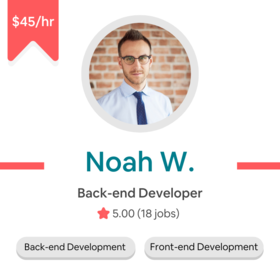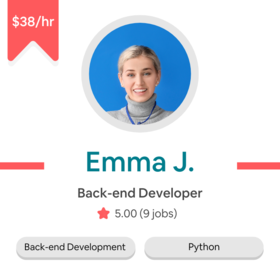













We understand that the process of building a website or web applications can be a long and hard. But not to worry as Cad Crowd maintains a massive network of professional back-end developers ready at any time to get your project started.
In today’s world, almost everyone uses the web for learning new things, following the daily lives of famous figures, watching movies, or even pay taxes. The web is easily navigated and the web pages are easy to use, efficient and most importantly, securely. Behind everything you see in the interface, there is the more technical stuff going on, built and maintained by none other than, back-end developers.
Front-end and Back-end are different, yes, but how big exactly do they differ? There’s a major difference between the two, and because of this, the other can’t do the other’s job.
Websites, web apps, and mobile apps consist of UIs and databases. When you use an app, you interact with the UI (front-end), and a database (back-end) that supports the UI functionality from behind the scenes. Both sides require solid knowledge of programming languages, but back-end development is often perceived as much more complex as it requires in-depth expertise in data structures and algorithms.
Users cannot access the back-end part of a web page; they don't even see it happening, although it's always running busy to provide everything the user needs. Take a Wikipedia page, for example. How does a page appear on your screen in the first place? The article and images for the page are stored elsewhere in one of Wikipedia's data centers. When your browser sends a request for a specific page or two, the data centers (or servers) retrieve the request and send a collection of the appropriate files to your screen.
In short, back-end development is all about data management on the servers, fielding requests from the front-end, processing the requests, and sending the data back to the front-end. Since the database keeps changing, the developers automate the process by using server-side software and perform regular maintenance to keep everything running efficiently.
You must define the job roles right when hiring back-end developers. Unless you've hired both front-end and back-end developers a couple of times before, things can get easily mixed between the two different professions' job roles. Our recruiters can help you create a concise list of tasks the candidates should do (if you do end up hiring them), depending on the project. Depending on your project size, our back-end developers will handle most, if not all, of the following tasks:
In a typical web or web app development project, back-end and front-end developers work hand in hand to ensure proper integration between the user interface and server-side programs. If the project is large enough, they also work with designers and DevOps engineers to improve workflow between developers and IT operations.
Now that you know what back-end developers do, you may wonder how they can do such complex tasks. Well, it might take back-end developers many years to go from complete rookies to professionals because they need to learn at least all these things.
All web and web app developers are coders whose primary role is to write codes for the application in order to manage and automate database and application logic. They write the codes in programming languages such as Python, Java, and PHP.
Of course, some back-end developers might prefer other programming languages, and there are indeed plenty of options. Among the most popular include Ruby and C. The former is considered high-level (human-friendly) language, so it is easier to learn, while the latter is low-level or machine-friendly.
The back-end developer’s job involves linking data to the corresponding buttons and navigation systems on the UI of web pages and apps. Website databases can be divided into two main categories: relational and non-relational. The former refers to data structured as tables (with related rows and columns), which means it requires a predefined schema using identifiers or keys; the latter represents every data structure other than tabular forms, and the storage model is optimized for the types of data being stored.
Back-end developers know how servers receive requests from client-side applications, process the requests for web pages, and store all related data. It is true that the size of servers affects web performance a great deal, but the software also plays a major role. Unless you want a static page that doesn't retrieve and send data apart from what's already on the page, you need server-side software.
Apart from the core competencies mentioned above, practically knowledge of the following subjects will prove helpful for back-end developers to handle their jobs better.
Soft skills are just as important. For example, back-end developers with good communication skills can explain all sorts of complex technical concepts in plain language. Sometimes, you just have to accept that not everybody involved in the project can understand all the technical jargon typically used in web development. It's not something anybody can learn in a day or two, so unfortunately, it does fall under the developers' responsibility to make sense of what they do.
All the things back-end developers do sound very technical, but that's only because everything is indeed technical. They write codes and build websites from the ground up, so most people may find the technicalities of the job difficult to decipher. They are the foundation of efficient web pages that we see on the daily.
Our recruiters are ready to lend a hand and find talented back-end developers for you. We have easy access to over 100,000 freelancers, both active and passive, in the tech industry. Whether you need entry-level or expert back-end developers, Cad Crowd is confident that we can create the perfect match. Contact Cad Crowd today or get your free quote and we can schedule a discussion regarding your project.
Ready to take your project to the next level? Cad Crowd's pool of talented back-end developers is on hand to deliver top-notch, reliable, and efficient server-side solutions for your business. Whether you're looking for a dedicated professional to handle a long-term project or need expert assistance on a one-off task, we've got you covered. Don't wait - explore our services or request a free quote and connect with a freelance back-end developer today! Your next big project success starts right here at Cad Crowd.


